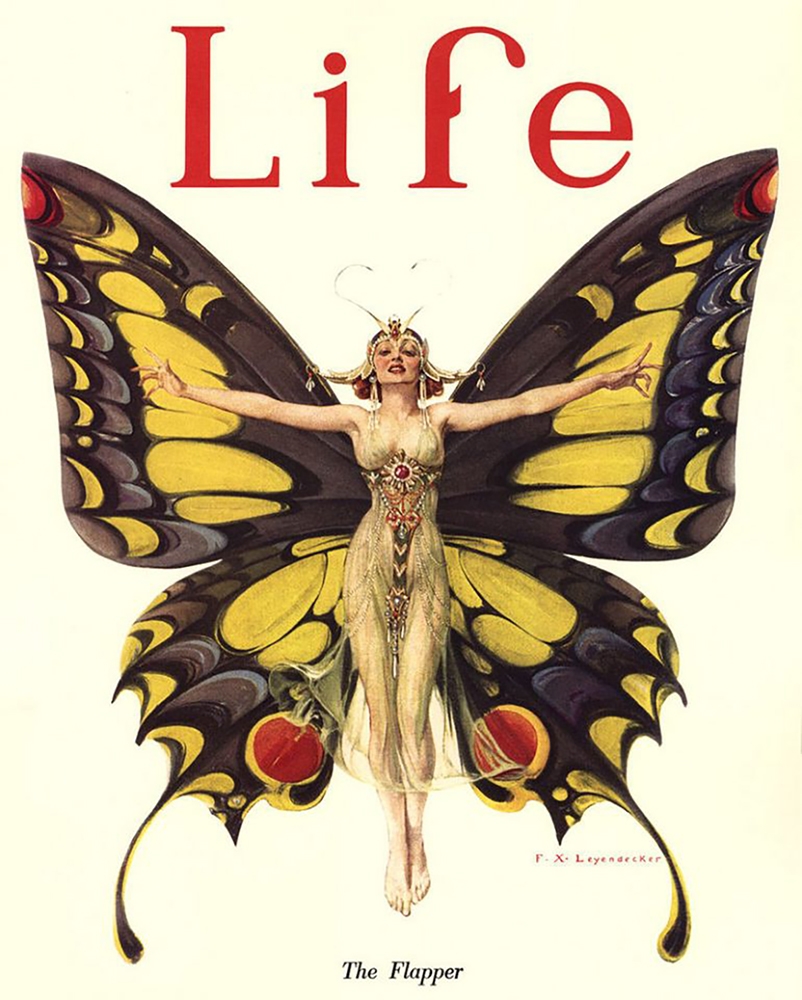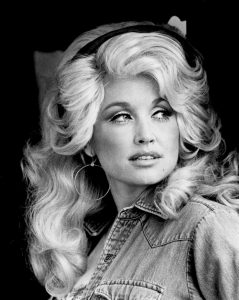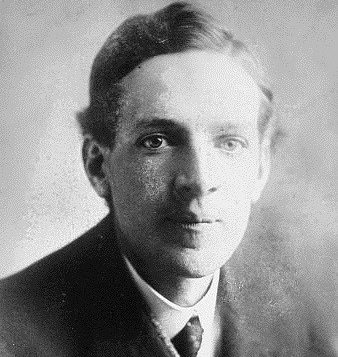Winner of the Fall 2016 StMU History Media Award for
Best Article in the Category of “Culture”
When one thinks of the 1920’s era one immediately thinks about Flappers. A flapper was considered a young woman who was very fashionable. This was a young female who enjoyed life to the fullest, flouting her unconventional standards of behavior and carefree party lifestyle.1 The spirit behind this movement was all about leaving the traditional ways of life behind and transforming into an independent woman.

Before World War I, the concept of femininity was referred to as the Gibson Girl. This term was used to describe these new independent and often well educated women. Gibson girls wore their hair long, pinned up and adorned with beautiful hats. They completed their ensemble by wearing long skirts and blouses that buttoned up to their necks. Despite their feminine appearance, these women were more than capable of doing the same things that men did. Examples of this include activities such as playing sports: skating, golfing, bicycling, tennis. These young ladies did not go out until they were asked properly by a young man who had good intentions and a promise of marrying them. Gibson Girls soon broke away from their traditional ways.2
In 1915, two years before America’s entry into World War I, a famous author by the name of H.L. Mencken introduced the word “Flapper” to the United States. Mencken stated that a flapper was “a woman who consumed music, literature and periodicals voraciously taking her cues for behavior and style from the media in front of her rather than the moral codes of decorum.”3 Another famous author, F. Scott Fitzgerald, famous for his classic novel The Great Gatsby, described the flapper as “lovely, expensive, and about nineteen.” John Held Jr., who was an American cartoonist, emphasized the flapper by drawing young girls wearing unbuckled galoshes that would make a “flapping” noise when walking.4 Despite the many different terms, Flappers were described essentially the same way: they were young girls who enjoyed the party life and had a sense of fashion.
After World War I ended in 1918, many things had changed for the men returning home, particularly the roles and values that women were embracing. The traditional values were gone and in their place came a faster, sleeker, and more daring approach to life. This time period not only ushered in an era of change in values, but it also established a new baseline for what was considered feminine. The Flapper Age was born and it brought with it a new and independent woman. These women smoked, drank, voted, cut their hair into bobs, wore eyeliner, and went to as many parties as they could—enjoying every bit of the social life along the way.5

During the 1920’s, fashion changed drastically due to a very famous designer, Coco Chanel. This woman helped flapper fashion to stand on its own. Typical flapper clothing included a simple sack like dress, which allowed women of all classes to make their own dresses and remain on trend.6 The waist of the dress was dropped to the hipline, and the skirt fell just below the knee. Stockings made of rayon were added and worn over a garter belt. To complete the look, bracelets were added and necklaces ran from the neck to the waist. Cloche hats sat atop their heads and drew the eye into a new hairstyle trend known as the bob.7 The make-up of flappers consisted of a red powder or cream that was used for the lips and cheek, eye-liner, powder for the face, and red lipstick that became very popular.
On January 19, 1919, the Eighteenth Amendment, also known as the Volstead Act, came into effect and gave way to the Prohibition Era in which the sale, production, importation, and transportation of alcohol was banned across the nation.8 This change in the legal system caused the sale and consumption of liquor and alcohol to go underground. The most rebellious thing a flapper could do at this time was to consume alcohol, and these young girls had a reputation for being giddy. The following year, on August 18, 1920, the Nineteenth Amendment was passed and women now had the right to vote.9 In 1924, the first radio launched more than 600 commercial channels around the U.S. The radio at the time was the social media on the flapper life. Many young girls swarmed the theaters to see the image of the flapper on screen. Famous actress Clara Bow, starred in the “Flapper” and made the look iconic.
On December 2, 1927, Henry Ford invented the Model A vehicle and car sales increased.10 Women were now owners of vehicles, and the car became a lifeline to a world full of excitement for the flapper in particular. With no one to stop them, they were free to come and go as they pleased. Liberated women were now able to go out and enjoy dancing during this era that was the Jazz Age. The most popular thing for a flapper to do was to go to a nightclub where she would drink, dance, and show off her moves. The era of the Flapper, however, came to an end with the Wall Street Crash of 1929. Many young women lost their jobs and the incomes that had given them such independence.11
Life in the 1920’s left a huge legacy for women to this day. Flappers and the forward-thinking concept of the modern woman is what initiated the change in society for how women were viewed then as well as how they continue to be viewed in present day. With their bold choice in attire, along with their new views and attitudes regarding femininity, both in fashion as well as social conduct, Flappers left behind the old traditional ways and paved the road for a more liberated female.
- Salem Press Biographical Encyclopedia, January 2016, s.v. “Flappers,” by R.L. Smith. ↵
- Kelly B. Sagert, Flappers: A Guide to an American Subculture (Greenwood Publishing Group, 2010), 1-2. ↵
- Brian DiPaolo, Flappers: Issues & Controversies in American History (Infobase Publishing, 2007), 4-5. ↵
- DiPaolo, Flappers: Issues & Controversies in American History, 4-5. ↵
- Soo Hyun Park, Flapper Fashion In the Context of Cultural Changes of America in the 1920’s (CUNY Academic Works, 2014), 1-2. ↵
- Salem Press Biographical Encyclopedia, January, 2016, s.v. “Flappers,” by R.L. Smith. ↵
- Sagert, Flappers: A Guide to an American Subculture, 3. ↵
- Sagert, Flappers: A Guide to an American Subculture, 5. ↵
- DiPaolo, Flappers: Issues & Controversies in American History, 2. ↵
- F.L. Allen, Only Yesterday: An Informal History of the Nineteen Twenties (National Humanities Center, 1931), 5. ↵
- Alan Brinkley, American History: Connecting with the Past Volume 2, 15 edition (New York: McGraw-Hill Education, 2014), 643. ↵




213 comments
Elianny
we have the same name also my teacher used this for an assignment so awesome job!
Elianny torres
we have the same last name TWINS
Lyle Ballesteros
I really liked this article! I enjoyed the detail you went in about the flappers and what fashion was that these young women would wear, and how the original creator made it intentionally with the concept of letting women of all riches and class to be able to adopt the style and move with the trends. Flappers were very revoltuionary in that they were the start of women in America becoming more indepenedent into now today, even if it stalled during the Great Depression which stalled many people and communties from moving forward.
Maggie Trujillo
Congratulations on earning Best Article in the Category of Culture!! This was an interesting article to read about flappers. I did not know Coco Chanel started the flapper fashion movement! Up until I read this article, I thought Coco Chanel was only known for perfume. I enjoyed reading this article and learning about how these young women (flappers) broke free of traditional roles at the time and experienced their “freedom” from social norms – even if it was just a few years until the Great Depression hit. It was definitely a time of growth and liberation for women in general.
Clarissa Liscano
It was great to learn more about 1920s fashion as I didn’t really know much about it. The attention to detail was one of the things I liked most about this article. The author goes into great detail regarding the outfits, accessories, and makeup. This, in my opinion, improved the article’s flow and made it more appealing. Well written article.
Isabel Soto
I found this article very interesting because it shows what fashion was like in the 20s. Flappers help change fashion to be more accessible to young women everywhere. I didn’t know that back in the day some women where called that.this article taught me a lot about this time era. It was an era to remember throughout those times.
Laurel Cox
It’s fascinating to see what war can do to not only the economy, but also to a society. Before World War I many women were relegated to the house and other domestic jobs without possibility for anything else, but one single slight from a war, and suddenly women can have jobs and show free spirit like never before. Also, I think interesting to know how people felt during the rise of the “flapper” because it is such a fascinating group, with a unique style which was considered “not proper” for the time.
Madison Magaro
This was a great article that described the culture of flappers. The 1920s was a time when women were starting to express themselves more through fashion and many other ways. The main idea of a flapper was for a women to be able to express herself and to enjoy the life of the party and live through fashion.
D'vaughn Duran
A great informational article that engrossed the reader! Flappers and the period go in hand because that was their fashion. This was fun to read about fashion and the history of “flappers.” Also, interesting how women tried being property till Gibon Girls broke the tradition of men controlling women’s lives. With that, men come back from war and women change their personalities, roles, and values.
Abbey Stiffler
Reading about the social influence and historical setting of the flappers is fascinating. It is incredible how the 1920s were a time when women could alter how society perceived them and began to express themselves through fashion, literature, and several other areas that helped them feel more liberated, shattering the conventional mold of how women should behave. Flapper girls contributed to making fashion more approachable for young ladies worldwide.